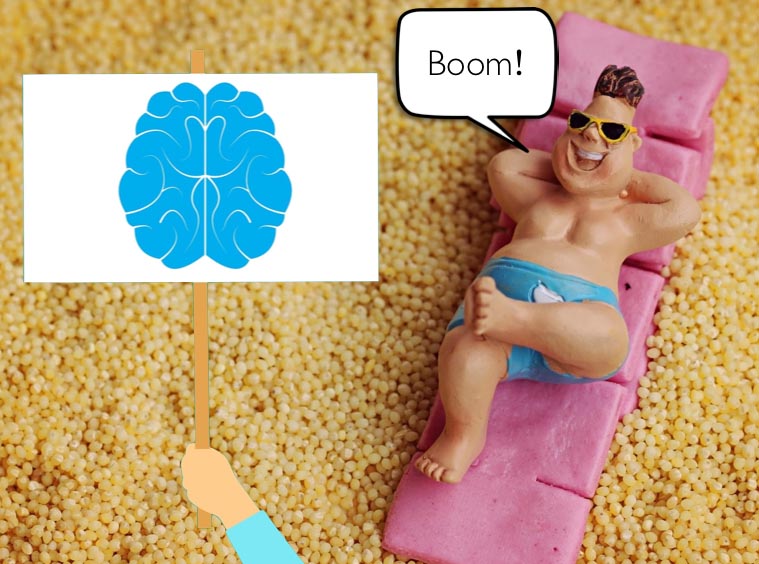
Then consider chewing on gum for 5 minutes before the test.
This is what researchers recommend in a journal article called Cognitive advantages of chewing gum. Now you see them, now you don’t. In this study, researchers from St Lawrence University conducted a series of gum chewing experiments. Students were split into different groups and were instructed to:
1) Chew gum for 5 minutes before taking a test;
2) Chew gum before and during taking a test; and
3) Not chew gum before or during the test (control group).
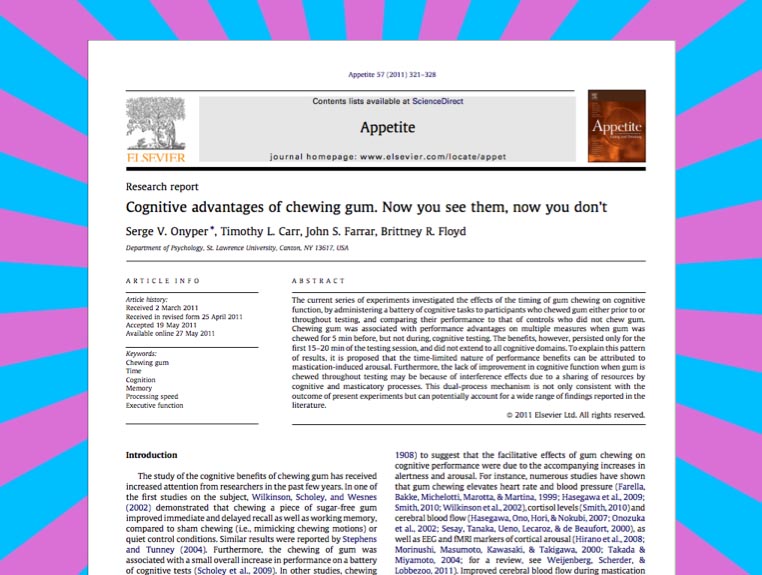
The researchers found that chewing gum for 5 minutes before the test gave students a boost in brainpower … but the benefits only lasted for 15-20 minutes.
Unfortunately, it didn’t.
In fact, other studies have found chewing gum during a test can negatively impact on your performance. Instead of dedicating 100% of your brainpower to answering the test question, some of your brainpower is directed towards the act of chewing the gum. In short, chewing gum is distracting.
So if you’re going to chew gum, do it right. Do it for 5 minutes before the test and then spit it out.

Three main theories have been proposed for the cognitive enhancing benefits of gum chewing:
1. Chewing gum results in the enhanced delivery of glucose to the brain.
2. Chewing gum makes you feel more alert.
3. Chewing improves blood flow in the brain.
Here’s what the researchers concluded in their discussion:
…there is evidence that some flavors lead to an amplification of cognitive effects, even in the absence of chewing …On the other hand, studies also reveal performance improvements after participants chew flavorless gumbase, suggesting that the presence of gum itself is sufficient to induce changes in cognitive functioning.
In case your wondering, the students in the St Lawrence gum chewing experiment chewed on Wrigley’s spearmint flavoured sugar-free gum and doublemint chewing gum.
My advice would be to choose a chewing gum flavour that you like. After all, if you don’t like it and it leaves a terrible taste in your mouth, this is likely to distract you in the test.
Most chewing gums contain a synthetic plastic (read more about it here). That’s like chewing on a gumboot or car tyre to get a short cognitive boost. It just isn’t worth it.

To be on the safe side, it’s best to purchase a natural plastic-free gum like Glee Gum.
Sugar content is also important to consider. Chewing on gums that contains sugar is like eating lollies. And the last thing you want to experience is a sugar crash during a test. Purchase sugar-free gums that are aspartame free.
Rate of chewing doesn’t seem to really matter. It’s the act of chewing that is most important. So set your own pace.
At the end of the day, it’s important to remember that chewing gum before a test will only deliver a short-lived boost in cognition. Chewing gum can never replace using effective study strategies or a good night’s sleep but it’s an extra evidence based tool we can add to our toolbox of strategies. Thank you, Science!
Share This:
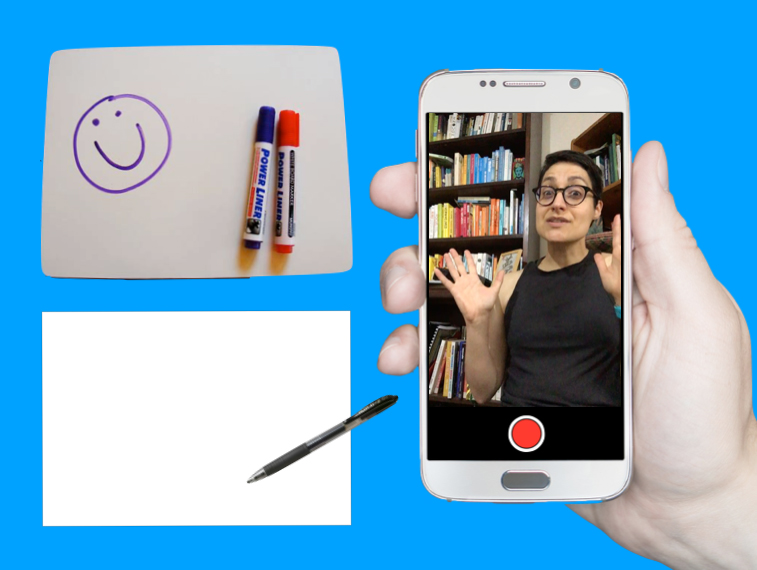
Research shows active recall (aka retrieval practice) is a highly effective strategy for remembering information. This strategy will take your studies and your grades to the next level.
Active recall involves bringing information to mind without looking at your books and notes.
I have spent the last 30 days experimenting with this excellent learning strategy. In this blog, I’ll share what I did and how I kept the process interesting for my brain.
I no longer need to study for tests and exams.
So, why did I spend 30 days using active recall strategies?
In my line of work, I need to constantly come up with new and original content to present to students. I also need to memorise this content. Why?
Because if I was to read from a sheet of notes or text heavy slides that would be really boring for students. I want to connect with students and to do this, I have to be able to deliver the content off the top of my head with speed and ease.
This is where active recall enters the picture.
Active recall helps to speed up the learning process. It allows you to learn more in less time.
Below I share some of the ways I use active recall to learn new presentation content. Keep in mind, you can use all of these strategies to prepare for an upcoming test or exam.
Whiteboards are wonderful learning tools. Here’s how I use a whiteboard to do active recall . . .
I push my speech notes to the side, so I can’t look at them. Then I grab a marker and say to myself, “What can you remember? Go!”.
I write out everything I can remember on the whiteboard. Once I’ve exhausted my memory, I pick up my notes and check to see how I went (using a red marker to make corrections).
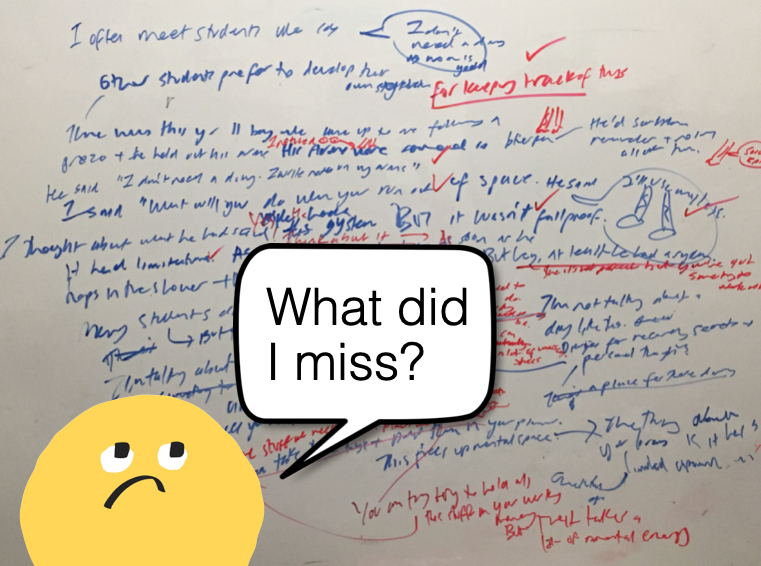
No whiteboard? No problem!
I pick up a pen and sheet of paper and start scribbling out whatever I can remember on the topic. When I get stuck, I pause and take a few deep breaths as I try to scan my brain for the information.
I regularly remind myself that it is okay to not remember the content. “This is how the process goes!”, I say to myself. There is no point beating myself up. That only leads to feelings of misery and not wanting to do active recall practice.
After having a shot at it, I take out my notes, pick up a red pen, and begin the process of checking to see how I went.
Sick of writing? I get it.
Try drawing out the information instead. Alternatively, you can use a combination of words and pictures, which is what I often do.
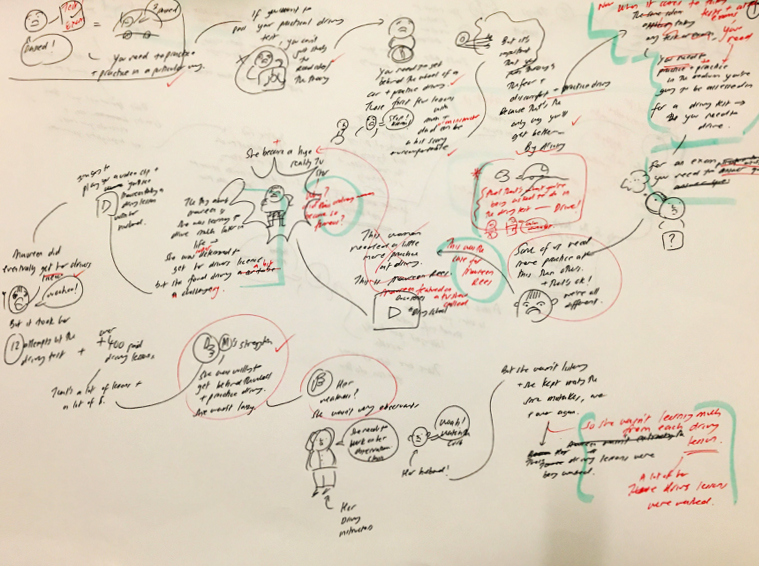
Grab a blank piece of paper (A3 size is best) and create a mind map of everything you can remember on a topic (no peeking at your notes). Then check your notes or the original mind map to see what you remembered correctly and incorrectly.
Writing and drawing out information can take time. If you want to speed up the process, you can talk to yourself.
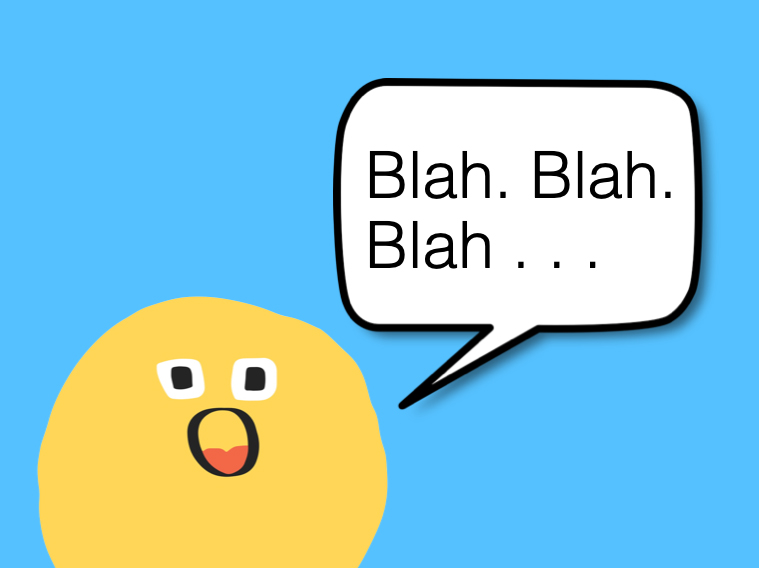
But don’t do this in your head. It’s too easy to just say “Yeah, yeah, I know this stuff!”. You need to speak it out loud as this forces you to have a complete thought. Then, check your notes to see how you went.
The only downside with this approach is you don’t have a tangible record of what you recalled, which brings me to the next strategy . . .
I make videos of myself presenting the content (without referring to my notes). Although I use special software and tools to make my videos, you don’t need any fancy equipment. Your phone will do the job. Here’s what you can do . . .
Set your phone up so the camera is facing you. Now hit the record button and tell the camera what you’re going to do active recall on. Have a shot at explaining the idea. Then stop recording and hit the play button.

Watching yourself struggle to remember information is often hard viewing. But this is where it’s super important to double down on telling yourself kind thoughts (e.g., “I’m still learning this content. It’s going to be rusty and feel clunky – that’s okay!”).
You need to take a deep breath and keep watching because the video will give you valuable feedback.
For example, if you stop midsentence and you don’t know how to proceed, that tells you something: you don’t know this stuff so well! Make a note. This part of the content needs your attention.
Hand your notes over to a friend, parent, or sibling. Now get them to ask you questions on the content.
I sat with my mum and showed her a print out of my slides for a new presentation. The slides were just pictures (no text).
As I went through the slides, I explained the ideas to mum. I made notes of any sections I was rusty on. Mum also asked lots of questions, which allowed me to think more deeply about the content.
When it came crunch time (a few days before the final presentation), I printed out my presentation slides (16 per page) and used each slide as a prompt. I’d look at the slide and say, “What do I need to say here?”.

Sometimes I wrote out what I’d be saying in relation to each slide (without looking at my notes). Then I checked my original notes to make sure I hadn’t forgotten anything.
It’s really important that you don’t skip the stage of checking to see how you went, especially as you become more confident with the content.
At times, I found myself thinking “I know this stuff! I don’t need to check my notes” but then another part would say, “You better just check . . . just to be on the safe side”.
I’m glad I forced myself to check because more often than not I would discover that I had missed a crucial point.
Zines are cute little booklets you can create on any topic you like. They are fun to make, so I thought I’d try making a mini zine on the main points of some new content I had to learn.
I folded up an A4 page into a booklet and then I sketched out the main points on each panel.
I create a deck of flashcards on some key ideas (question on one side and the answer on the back) and then I test myself with them.
I read the question and before flipping the card, I write out the answer on a sheet of paper or say it out loud. Then I check to see how I went.
The beauty of flashcards is they are small and portable (they can easily fit in your pocket or bag). Whenever you have a spare minute or two, you can get a little active recall practice in.
It’s not enough to do active recall just once on the content you need to learn. For best results, you want to practice recalling the information several times over a period of time.
I didn’t follow a strict schedule for the 30 days. I had my notes for each important chunk of information I had to learn pinned to eight different clipboards.
Every morning, I’d pick up a different clipboard and I’d practice that specific content. I knew as long as I’d had a good night’s sleep in between practice sessions that the information was being strengthened in my brain.
Doing active recall is a bit like doing a high intensity workout: it can be exhausting. But you must remember, just like a high intensity exercise session is an effective way to train and get fit, active recall is an effective way to learn. Unlike less effective strategies (e.g., rereading and highlighting), you can learn a lot in a short space of time with active recall.
The key is to expect the process to be a little uncomfortable. Don’t fight the discomfort. If you trust the process and persevere, it won’t be long before you begin to see amazing results.
Just because active recall is challenging to do that doesn’t mean you can’t have fun with it.
Using a combination of different active recall strategies is one way to keep things fresh and interesting for your brain. But you may wish to try the following things to add a little boost of fun to your active recall sessions:
• Use a different type of pen
• Use a different coloured pen
• Change the type of paper or notebook you use (e.g., instead of using lined paper, use blank A3 paper)
• Incorporate movement into your active recall sessions (e.g., walk and test yourself with some flashcards)
• Change your study environment (e.g., go to the library or study outside)
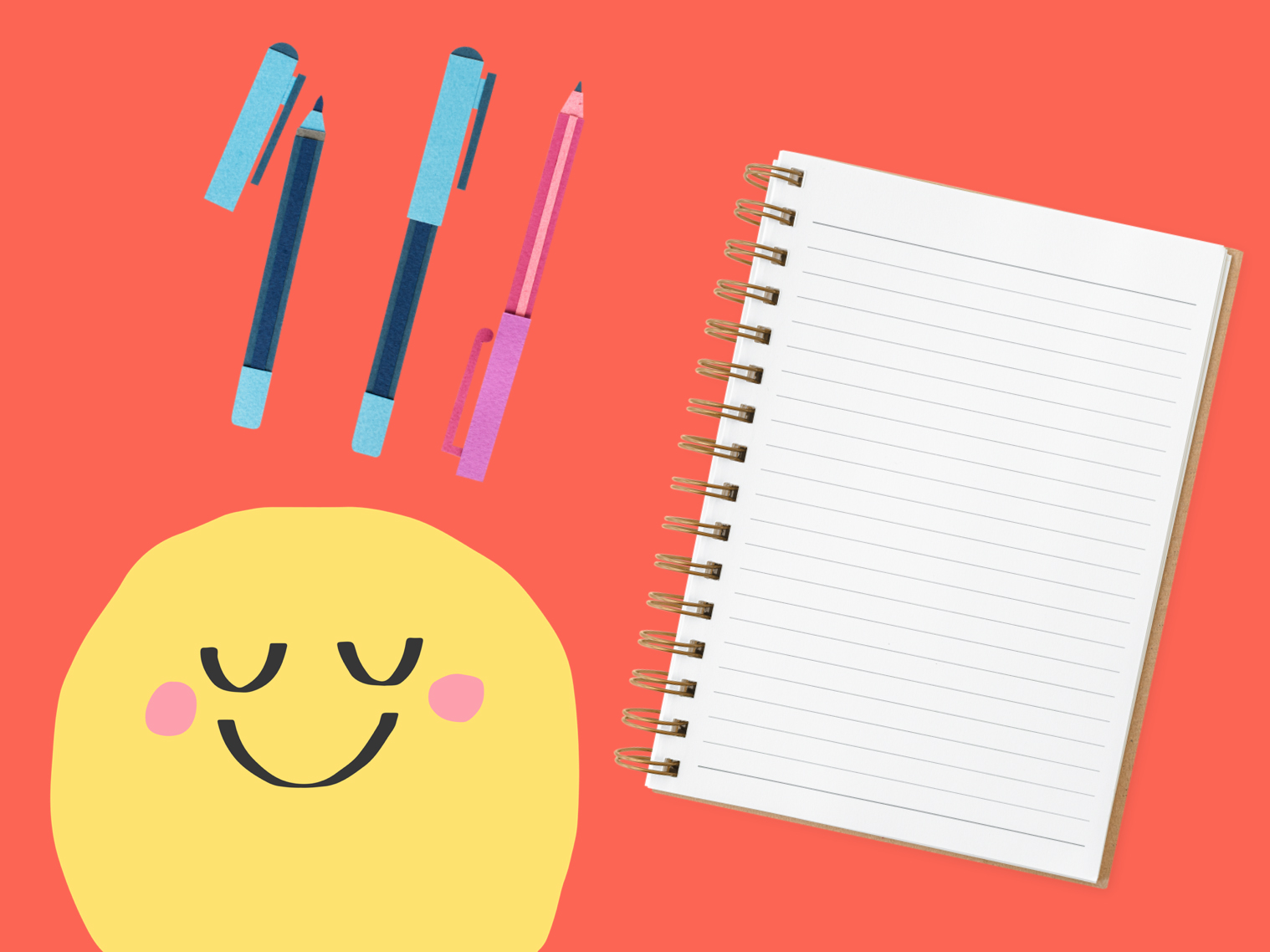
Like I said, active recall is challenging to do, especially when you first start learning new content. You can feel awkward and clumsy. For this reason, it’s easy to make excuses to get out of doing it (e.g., “I’m too tired”, “I’m not ready to do it”, and “It’s not the right time”).
This is where you need to harness the power of habits.
Find a set time in your day to do a little active recall practice. For instance, during my 30 days of active recall, I scheduled my practice sessions for first thing in the morning. I knew after I washed my face, I would sit down to practice.
Incorporating active recall into my morning routine worked really well for me. I was getting the hardest thing done first thing in the day. And once it was done, I could relax. It was done and dusted!
At a certain point, I became more confident with the content and I found I was on a roll. I felt motivated to do active recall.
This is when I started to look for spare moments in the day to squeeze in a few extra mini practice sessions.
For example, one day I found myself waiting in a car. I grabbed a paper shopping bag and started scribbling out the content onto the bag. As soon as I got home, I checked the shopping bag against my notes.

I hope you can see that there’s no one set way to do active recall. This is a highly effective strategy you can be creative with. As long as you’re testing yourself and checking to see how you went, you can’t go wrong.
And if you do make a mistake? It’s no big deal. If you check to see how you went, you won’t embed the error in your long-term memory.
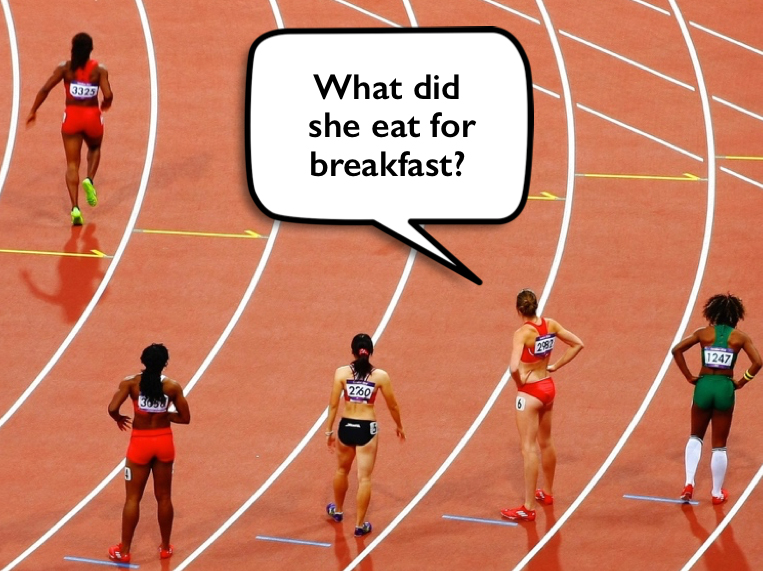
This means you need to prepare yourself mentally and physically for them.
You can work so hard to memorise large quantities of information for an exam, but if you’re not mentally and physically prepared, all that hard work can sadly go to waste.
When it comes time to take your exams, you have to relate to yourself as a professional athlete. Leading up to the day of the big performance (i.e. the exam), you need to eat nutritious food, be in the right frame of mind, manage your nerves, and allow your body to rest. These simple things can make all the difference to your exam performance.
You may be thinking “But isn’t this just common sense?”
It is! But creating healthy habits takes time and practice.
It’s one thing to intellectually know you should be eating well but it’s another thing altogether to incorporate healthy meals and snacks into your lifestyle.
I see a lot of students drinking energy drinks, getting very little sleep, and eating highly processed foods in the days leading up to exams. I have to admit, there was a time when I engaged in these behaviours too. I can tell you from personal experience, this is a recipe for mediocre grades and a miserable existence.
Here are my top 10 tips to prevent burnout and boost exam performance:
Sleep is critical to the learning process, exam performance, and wellbeing. Yet it’s usually the first thing students sacrifice to get more study done.
If you miss two hours of sleep each night for a week, the cognitive effects are as bad as going without sleep for two days straight!
Studies have also found that if you stay awake for 18 hours straight that’s like having a blood alcohol level of 0.05. In other words, it’s like being legally drunk. Your ability to focus, think, and learn will be seriously impaired.
You can’t adapt to getting less sleep. As adolescents, you need about 9-10 hours of sleep per night to be as alert as possible when you wake up.
If that feels unachievable, try to just get an extra 15 minutes of sleep tonight. Gradually increase this each night until you reach your target.
Often students stop exercising when they start preparing for exams. They think “I don’t have time to exercise!”. It’s as if they think they must spend every moment studying. Don’t fall into this trap.
Movement is your friend when it comes to studying for exams.
Research shows engaging in regular physical movement will help you to study more effectively. Firstly, it’s a great way to relieve stress and release feel good chemicals. Secondly, it gets the blood flowing more efficiently to your brain, which can give you a cognitive boost.
One study found students who engaged in 5 minute movement breaks every 17 minutes during a lecture retained more information and could focus better.
Every time you engage in a short movement break, you’re enhancing your study sessions.
Research has found that students who skip breakfast experience a decrease in cognitive performance and alertness compared to students who eat breakfast.
Eating a nutritious breakfast will give you a cognitive boost before an exam. It will also help you to feel fuller for longer, stabilise your mood, and give you plenty of energy to get through the exam.
Here are some healthy breakfast ideas:
Muesli or porridge with nuts and fresh fruit (e.g., berries) Wholemeal toast with a variety of toppings (e.g., baked beans, tomatoes, and avocado) and a piece of fruit A healthy homemade smoothie (click here for my brain boosting smoothie recipe)
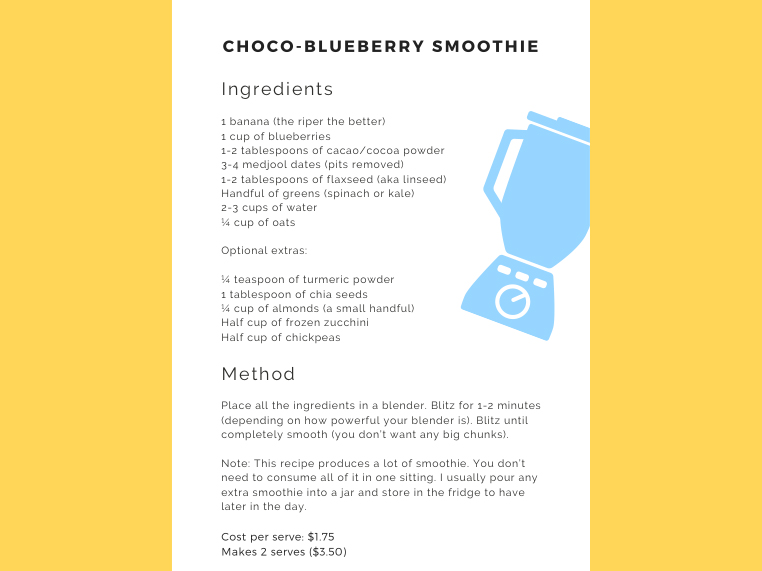
Your brain requires adequate hydration to function properly. Drinking water ensures that your brain receives the necessary fluids to perform tasks efficiently, such as retaining information and problem-solving.
Take regular sips of water as you study. It’s a good idea to have a glass of water or a reusable drink bottle within arms reach.
You may even want to create a tiny habit to remind yourself to engage in this simple behaviour (e.g., “After I finish answering a practice exam question, I will take a sip of water”).
Many years ago, I started thinking that my teachers and lecturers were out to get me. I thought they would mark me down wherever they got the chance. As a result of this distorted thinking, I became too scared to write anything in one of my first tests at law school. After receiving a terrible grade (5%), my brother said to me:
“Remember sis, your teachers want you to do well. They will try to give you marks wherever they can. It’s in their best interest to do so.”
Don’t worry about writing a perfect answer. If you’re unsure, be brave and still write something down. Even if it’s just a few dot points, it’s better than nothing. You may not get any marks for it, but your teachers won’t take marks off.
Just remember, most of the time your teachers are on your side and they want you to succeed. When you do well, it makes them look good.
Chances are there will always be something that you could have studied more thoroughly come the day of your exam. But on the morning of an exam, you can’t do much about that, so there’s no point worrying. Worrying will just deplete your finite energy, which you need to conserve for the exam.
Instead of worrying, try saying this to yourself before each exam:
“I now know so much more than I did before. I’ll be able to answer many questions in this exam.”
Telling yourself this positive micro-thought will allow you to enter the exam in a calm and confident frame of mind.
It’s normal to feel a bit nervous before an exam. But there are certain things and people that can push your anxiety levels into dangerous territory and impair your exam performance.
For example, coffee and energy drinks will skyrocket your stress levels. Similarly, hanging out with people who have a lot of nervous energy and are venting about the exam (“I’m going to fail!” and “I hardly studied!”) are going to leave you feeling distracted and a little jangled.
Before the exam, do your best to isolate yourself from these people. If you’re worried about offending someone who is venting to you, you could say “I’m sorry but I really need to do some last minute cramming”. Then proceed to pull out your notes and pretend to read them.
How many times have you stayed back after an exam to talk to your friends about what you put for each question? Have you ever felt terrible after doing this?
It can be reassuring to know that you wrote the same answer as your friends. But if you find out that you wrote something completely different, you may start to second guess yourself. If you have another four or five exams to go, this may throw you off your game.
This is why I don’t recommend engaging in a postmortem of the exam until you get your results/exam paper back.
When you walk out of the exam room, tell yourself:
“That exam is over. There’s nothing I can do to change how I went. It’s time to move on!”.
You could imagine yourself locking the exam in a box and throwing it off a cliff or rolling it up and stuffing it in a bottle and throwing it out to sea. The point is you need to mentally disconnect from that exam and focus on studying for the next one.

If you come across a question that you’re not sure how to answer, stop for a moment and take a few deep breaths (in for the count of 4 and out for the count of 4).
A simple breath activity you can try is the Box Breathing Technique. This involves imagining yourself breathing along the sides of a box (breathing in for the count of four on one side, out for the count of four on the next side, etc). Repeat this 2-3 times. Then take a look at the question again.
If you are still unsure how to answer the question, move on to another question.
The worst thing you can do is panic (remember, stress impairs your ability to think and recall information).
By engaging in Box Breathing, you can help yourself to remain in a calm and stable state.
Many of us are familiar with writer’s cramp. This can be caused by gripping onto your pen too tightly. Try loosening your grip a little.
Alternatively, experiment with a range of different pens. Some biros require you to press down hard on the page to make a mark, but not gel pens. The ink just flows onto the page!
The reality is, even with a good gel pen, your elbow will start to hurt at some point if you’re taking a 3 hour exam. When it does start to hurt, have a rest for a few seconds (yes, you have time to do this). Stretch your arm out. Shake it a little.
Treat each exam like a mountain hike rather than a 100 metre sprint. Resting for a few moments here and there will be time well spent and will enhance your overall performance.
These simple strategies can help to elevate your exam performance. My advice is to start small. Even if your exams are several weeks away, select one or two of these ideas and start testing them out today. At first, the strategies will require a bit of mental effort. But like anything in life, if you persevere they’ll become second nature to you and they’ll just be things you do without even thinking.
Want to learn more exam strategies? Click here to download a free copy of 70 ways to ace your exams.

If so, you could be suffering from decision fatigue.
Decision fatigue occurs when you have to repeatedly make decisions. Every decision you make takes effort and depletes some of your mental resources. By the end of the day – after making hundreds of decisions – you feel mentally drained.
You struggle to make simple decisions (e.g., “What will I have for dinner?”) and the quality of your decisions deteriorates too (“I’ll get Uber eats”).
In the book The Gap and The Gain, Dr Benjamin Hardy describes decision fatigue as follows:
“Decision fatigue happens when you’re not sure what you’re going to do. It’s when you’re torn between options and, due to your indecisiveness, you often cave to the tempting worse option.”
Sound familiar?
Instead of studying, you go on social media.
Instead of cooking a healthy meal for dinner, you order greasy fish and chips.
Instead of getting to bed at a reasonable hour, you watch another episode on Netflix.
Unless you have the self-discipline and mental clarity of a Zen master, decision fatigue is something we have all experienced.
Research has found even people who are expert decision makers (i.e., judges) suffer from decision fatigue.
In one study researchers examined 1,112 judicial parole decisions by eight experienced judges at different times throughout the day.
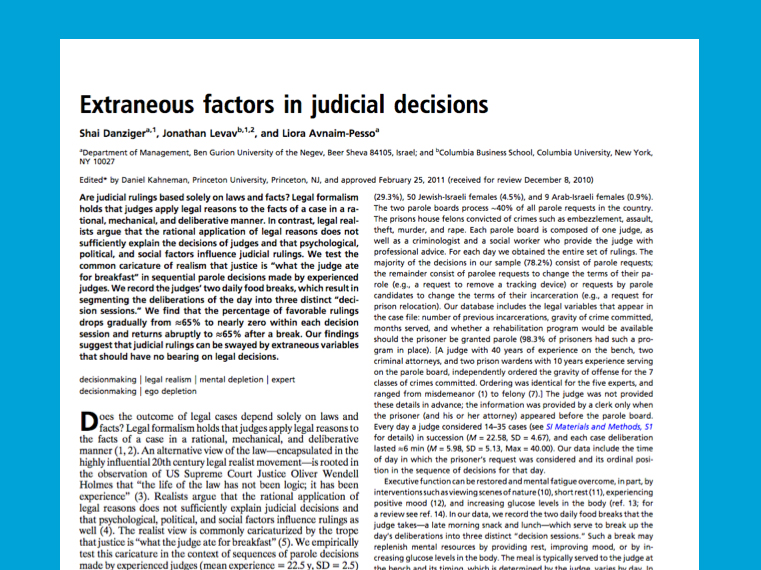
The researchers found if prisoners appeared before the judges at the very beginning of the day or after a food break (morning tea or lunch), they were more likely to get granted parole than prisoners who appeared later in the sequence of cases in a session.
In fact, they found the probability of a favourable decision dropped from 65% to almost 0% from the first ruling to the last ruling with each sitting session.

What was going on?
When the judges started their work day, they had a lot of mental resources available. One would assume these judges had slept well and had some breakfast.
But as each sitting session progressed, each decision they made depleted their mental resources and executive function. Just before morning tea or lunch, their mental resources would have been running low.
The researchers argued that when the judges had limited mental resources they became increasingly punitive. They simplified their judicial decisions and went with the status quo which was to deny parole requests.
This phenomenon is known as the Irrational hungry judge effect.
What do you do with a hangry judge?
Give them plenty of breaks and food.
In this study, the judges’ mental resources seemed to be replenished and their decision making ability restored after morning tea and lunch breaks.
What does this research on hangry judges have to do with your studies and work?
Here’s how it relates . . .
For optimal brainpower, you have to schedule in rest breaks. If you don’t schedule in regular rest breaks, they often don’t happen. You also need to take care of yourself with healthy food and healthy lifestyle practices and eliminate trivial decisions wherever you can.
Here are some simple and practical things you can do to overcome decision fatigue and keep your mental resources topped up:
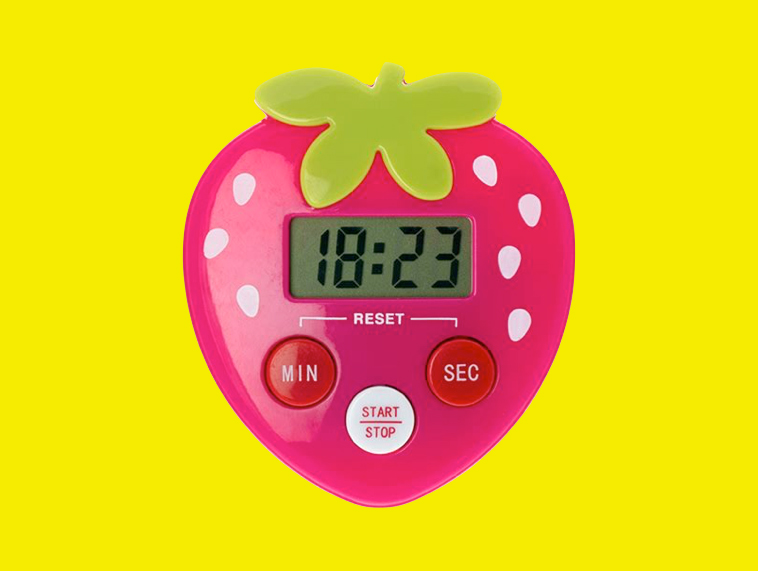
I like to have a digital timer within arms reach at all times when I’m working. At the start of a work session, I’ll set the timer for 20-30 minutes. When the timer goes off that’s my cue to get up and move.
The timer reminds me that:
1) I’m not a robot; and
2) I need to take breaks to replenish my mental resources.
Clicking and scrolling through your social media feed can rapidly deplete your mental resources. Jumping around the Internet from one random post or video to another can erode your attention and willpower. As the Center for Humane Technology states:
“When endless content creates an overwhelming amount of want, we can end up addicted to seeking satisfaction, clicking and scrolling, mindlessly consuming content, often with minimal oversight from cognitive control regions of the brain. Ultimately, this behavior drains our energy.”
Social media algorithms also promote content that provoke angry reactions over neutral and positive reactions. When you see posts that fill you with anger and other negative emotions (e.g., fear, envy, and anxiety), this can also leave you feeling drained.
So, be intentional about your social media use. Ask yourself, “Why am I going on here? What’s the point?” If it’s for fun and/or entertainment, that’s fine. But it’s a good idea to have your digital timer nearby and set a time limit. When the timer goes off, say out loud “That’s enough. I’m getting off!”.

Your brain needs energy to function at an optimal level. Where does it get that energy from?
Simple answer: food.
Author of The Willpower Instinct Dr Kelly McGonigal recommends fuelling your body with foods that give you lasting energy. She states:
“Most psychologists and nutritionists recommend a low-glycemic diet- that is, one that helps you keep your blood sugar steady. Low-glycemic foods include lean proteins, nuts and beans, high-fiber grains and cereals, and most fruits and vegetables-basically, food that looks like its natural state and doesn’t have a ton of added sugar, fat, and chemicals.”
Establishing habits, pre-planned responses, and checklists reduces the number of decisions you need to make, subsequently preventing decision fatigue.
I’m a big fan of tiny habits and implementation intentions to help streamline the day. I also have a folder of checklists to help me pack equipment for various trips, work jobs, and community events.
These checklists make all the difference, especially when packing for trips away. The night before I go away, I grab my packing list and start throwing items into my bag. Very little mental effort and/or decision making is required! I get to start my holiday full of energy rather than feeling mentally depleted and grumpy.
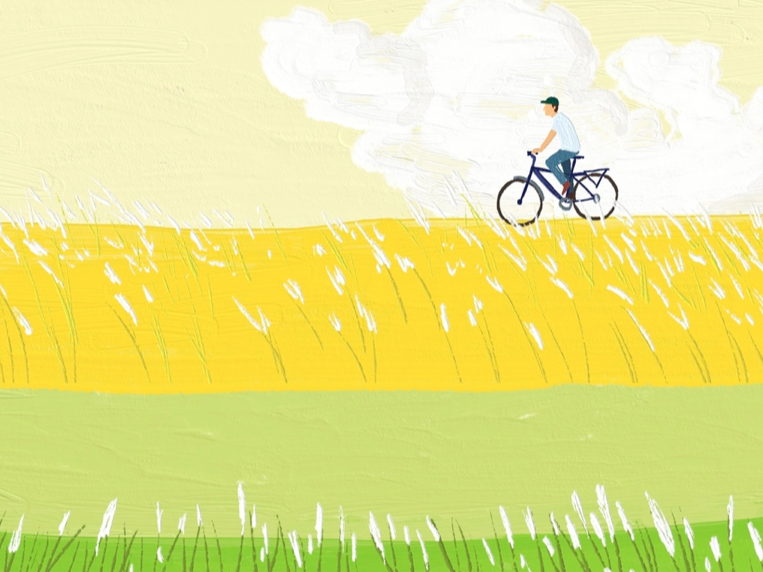
If you’re feeling overworked and mentally frazzled, head outside for a good dose of nature. Research by Hartig shows nature can restore deficits in attention and make people think and feel better.
I understand when you’re feeling tired, the last thing you want to do is get up and move. But research shows a five minute walk can do your brain the world of good.
One study found taking six regular five minute walking breaks every hour left people feeling more energised and less fatigued than people who just took one 30 minute walking break and sat for the rest of the day.

Can you lay out your clothes the night before? Pack your lunch and bag before you go to bed? Write a short to-do list for the next day? If you can knock off a few trivial decisions the night before, this is going to lighten your mental load the next day.
I love the energising effect of taking a post-lunch/afternoon siesta. I started taking power naps when I was an exchange student in Italy. My Italian host mother insisted I take a nap after lunch (it’s what everyone in the village did). So, when in Rome . . .
I grew to love taking naps. In fact, I’ve continued the practice for the past 20 years.
I recommend limiting your naps to 15-30 minutes in duration (any longer and you risk waking up feeling groggy). To avoid messing with your sleep at night, make sure you take your nap before 5pm.
We can all learn a thing or two from the example of the punitive behaviour of the hangry judges. To avoid the Irrational hungry judge effect you need to take care of yourself.
The good news is there’s a lot you can do to replenish your mental resources. If you take a few minutes here and there to engage in tiny self care practices, not only will you feel better but you’ll more likely make better decisions.
Dr Jane Genovese delivers interactive sessions on learning to learn, combating procrastination, exam preparation, how to focus in the age of distraction, habit formation and much, much more!
Get FREE study and life strategies by signing up to our newsletter:
© 2024 Learning Fundamentals